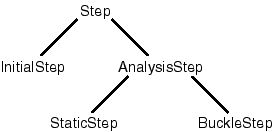Abstract base type | ||
| ||
In Figure 1 AnalysisStep and Step are both abstract base types. In terms of the real world a static step is an analysis step and a static step is also a step. In terms of the object model a StaticStep object is an AnalysisStep object and a StaticStep object is also a Step object.

In contrast the object model figures described at the beginning of this section show what object-oriented programmers call has a relationships between objects. For example, a session has a viewport repository, and a model has a root assembly.
Abaqus uses the name of the abstract base type as the name of the repository that contains objects of similar types. For example, the StaticStep, BuckleStep, and FrequencyStep constructors all create objects in the steps repository. Other abstract base types include Amplitude, BoundaryCondition, Datum, Field, Interaction, and Section.
The term abstract implies that the Abaqus object model does not contain an object that has the type of an abstract base type. For example, there are no objects of type Load or Step in the Abaqus object model. In contrast, the Feature object is a base type, but it is not abstract. The Abaqus object model includes Feature objects.